What Was It Like When We Lost The Last Of Our Antimatter?

The Universe was born matter-antimatter symmetric. Here’s what happened when the last of our antimatter disappeared.
Things happen fast in the earliest stages of the Universe. In the first 25 microseconds after the start of the hot Big Bang, a number of incredible events have already occurred. The Universe created all the particles and antiparticles — known and unknown — it was ever capable of creating, reaching the highest-ever temperatures it ever attained. Through a still-undetermined process, it created an excess of matter over antimatter: just at the 1-part-in-a-billion level. The electroweak symmetry broke, allowing the Higgs to give mass to the Universe. The heavy, unstable particles decayed away, and the quarks and gluons bound together to form protons and neutrons.
But in order to get the Universe as we recognize it today, a number of other things must occur. And the first of those, once we have protons and neutrons, is to get rid of the last of our antimatter, which is still incredibly abundant.
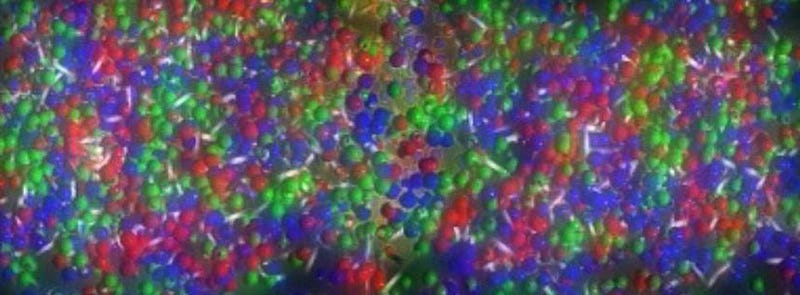
You can always make antimatter in the Universe, so long as you have the energy for it. Einstein’s most famous equation, E = mc², works two ways, and it works equally well in both of them.
- It can create energy from pure matter (or antimatter), converting mass (m) into energy (E) by reducing the amount of mass present, such as by annihilating equal parts matter with antimatter.
- Or it can create new matter from pure energy, so long as it also makes an equivalent amount of the antimatter counterparts for each matter particle it creates.
These annihilation-and-creation processes, so long as there’s enough energy for creation to proceed smoothly, balance out in the early Universe.
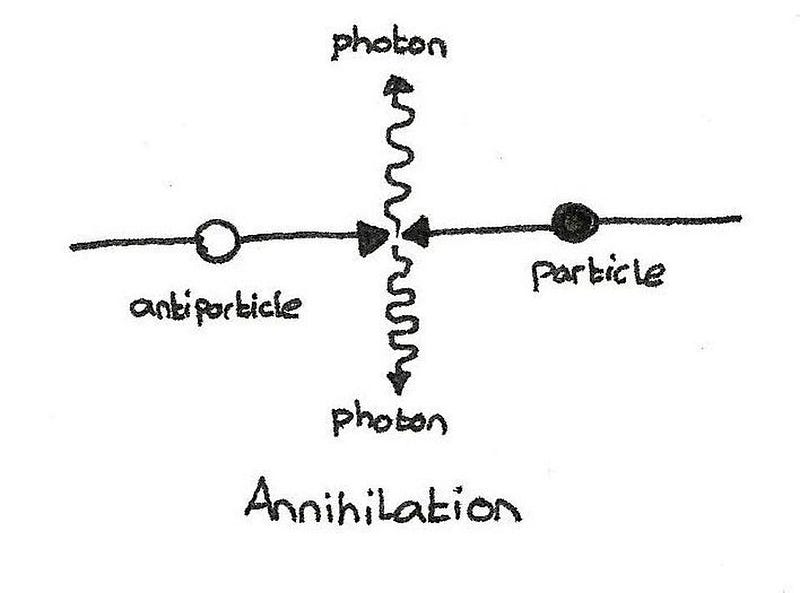
In the earliest stages, its the heaviest particle-antiparticle pairs that disappear first. It takes the most energy to create the most massive particles and antiparticles, so as the Universe cools, it gets progressively less and less likely that the quanta of energy that interact can spontaneously create new partice/antiparticle pairs.
By time the Higgs has given mass to the Universe, things are too low in energy to create top quarks or W-and-Z bosons. In short order, you can no longer create bottom quarks, tau leptons, charm quarks, strange quarks, or even muons. Right around that same time, quarks-and-gluons bind together into neutrons and protons, while antiquarks bind together into anti-neutrons and anti-protons.
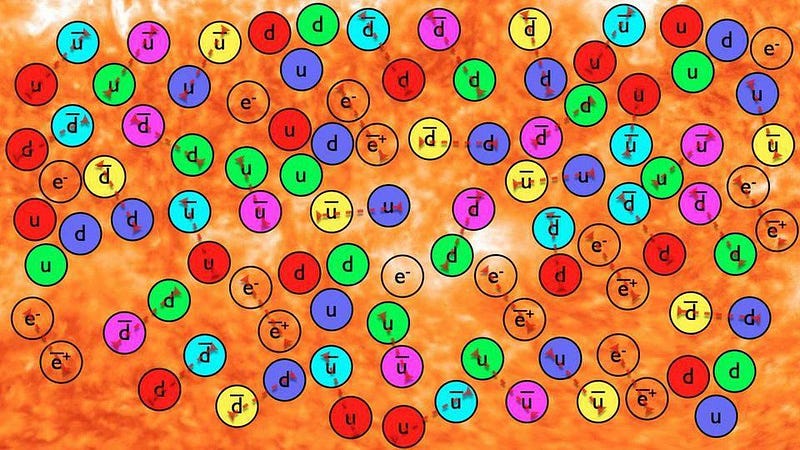
The energy available in the Universe is now too low to create new protons/antiproton or neutron/antineutron pairs. so all the antimatter annihilates away with as much matter as it can find. But since there is somewhere around 1 extra proton (or neutron) for every 1.4 billion proton/antiproton pairs, we’re left over with a small excess of protons and neutrons.
But all the annihilations give rise to photons — the purest form of raw energy — along with all the prior annihilations that gave rise to photons as well. Photon-photon interactions are still going strong at this early, energetic stage, and they can spontaneously produce both neutrino-antineutrino pairs and electron-positron pairs. Even after we make protons and neutrons, and all the antiprotons and antineutrons disappear, the Universe is still rife with antimatter.

It’s important to remember, even at this relatively late stage in the game, how hot and dense things still are. The Universe has had just a fraction of a second go by since the Big Bang, and particles are packed tighter everywhere than they are, today, at the center of our Sun. Most importantly, there are a slew of interactions constantly occurring that can change one type of particle into another.
Today, we’re used to the weak nuclear interactions occurring spontaneously in one context alone: that of radioactive decay. Higher-massed particles, like a free neutron or a heavy atomic nucleus, emit daughter particles that are less massive, giving off some energy in accord with that same equation Einstein put forth: E = mc².
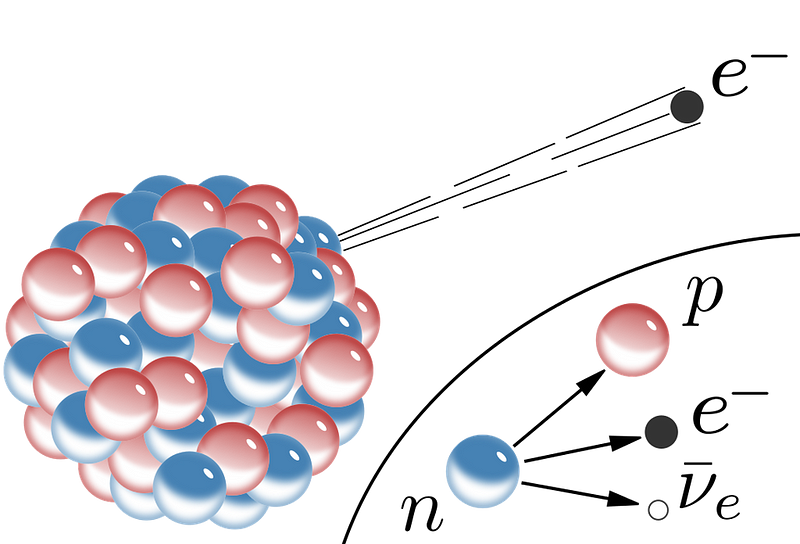
But in the hot, dense, early Universe, there’s a second role for the weak interaction to play, enabling protons and neutrons to convert into one another. So long as the Universe is energetic enough, here are some reactions that occur spontaneously:
- p + e- → n + νe,
- n + e+ → p + anti-νe,
- n + νe → p + e-,
- p + anti-νe → n + e+.
In these equations, p is for proton, n is for neutron, e- is for electron, e+ is for positron (anti-electron), while νe is an electron-neutrino and anti-νe is an anti-electron-neutrino.
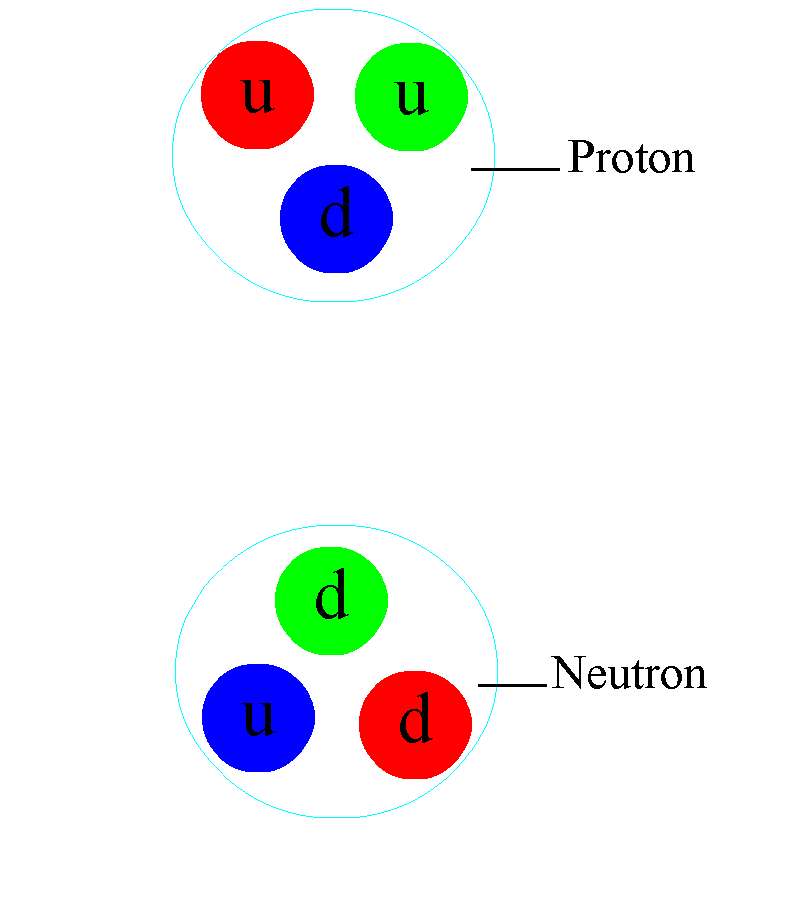
So long as temperatures and densities are high enough, all these reactions occur spontaneously and at equal rates. The weak interactions are still important; there’s enough matter and antimatter for these reactions to occur frequently; there’s enough energy to create higher-massed neutrons out of lower-massed protons.
For about the first full second after the Big Bang, everything is in equilibrium, and the Universe interconverts protons-and-neutrons at will.
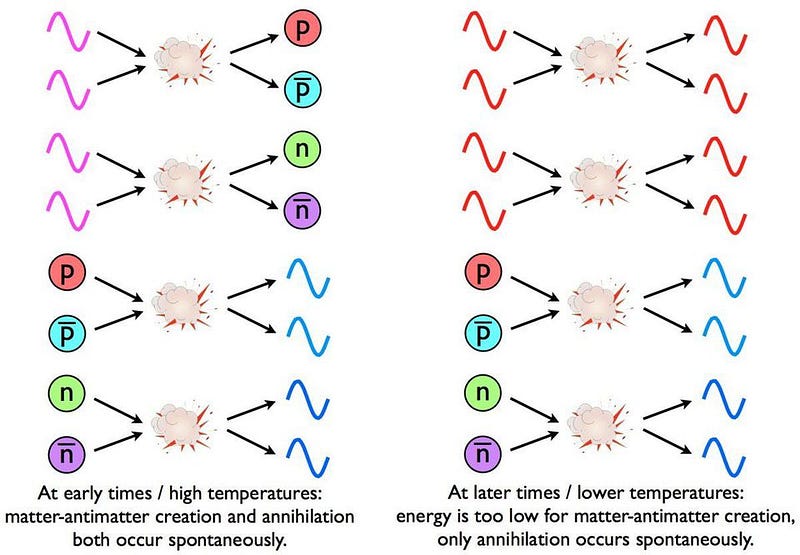
But in this Universe, very few things are destined to last forever, and that includes these interconversions. The first important thing that happens to change this is that the Universe is cooling. As temperatures drop from trillions of K to billions of K, the majority of neutrons colliding with either positrons or electron-neutrinos can still produce protons, but the majority of protons colliding with either electrons or anti-electron-neutrinos now no longer have enough energy to produce neutrons.
Remember that even though protons and neutrons have almost the same mass, the neutron is slightly heavier: 0.14% more massive than the proton. That means when the average energy (E) of the Universe drops below the mass difference (m) between protons and neutrons, it gets easier to turn neutrons into protons than protons into neutrons.
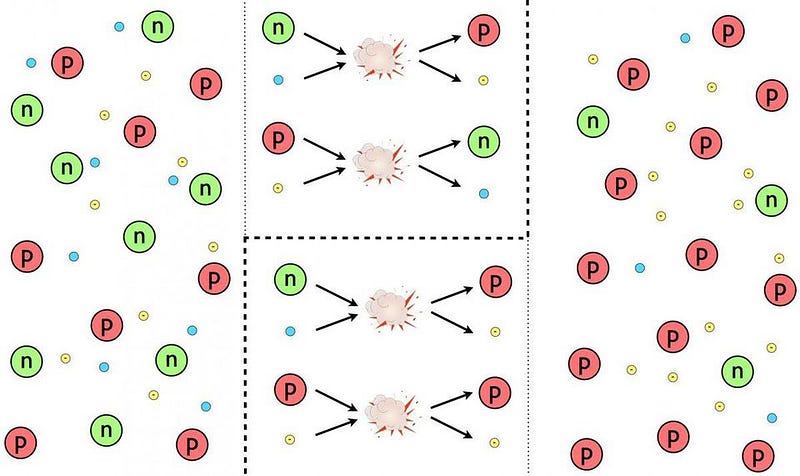
Protons start dominating neutrons right around the time the Universe reaches one second after the Big Bang. But then at that moment, two additional things happen in rapid succession, forever altering the course of the Universe. The first is that the weak interactions freeze out, meaning that the proton-neutron interconversion interactions stop occurring.
These interconversions required neutrinos to interact with protons and neutrons at a certain frequency, which they could so long as the Universe was hot and dense enough. When the Universe gets cold and sparse enough, the neutrinos (and antineutrinos) no longer interact, meaning that the neutrinos and antineutrinos we’ve made at this point simply ignore everything else in the Universe. They should still be around at present, with a kinetic energy that corresponds to a temperature of just 1.95 K above absolute zero.
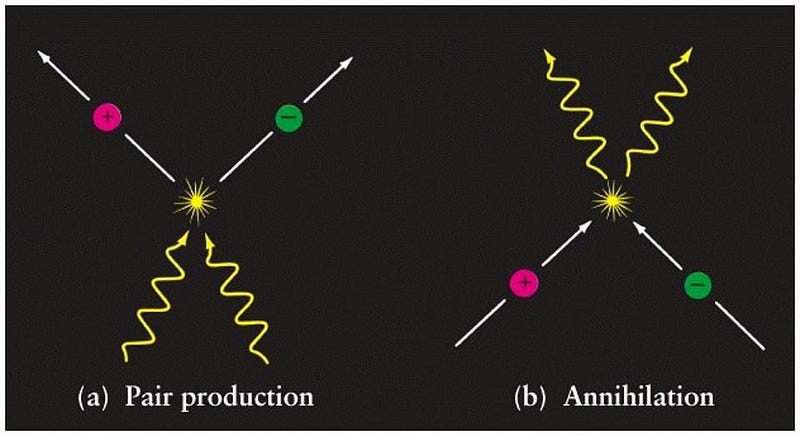
On the other hand, the Universe is still energetic enough that we can collide two photons to produce electron-positron pairs, and annihilate electron-positron pairs into two photons. This continues until the Universe is about three seconds old (as opposed to the one second freeze out for neutrinos), meaning that all the matter-antimatter energy tied up in electrons and positrons goes exclusively into photons when they annihilate. This means that the temperature of the leftover photon background — known today as the Cosmic Microwave Background — should be exactly (11/4)^(1/3) times hotter than the neutrino background: a temperature of 2.73 K instead of 1.95 K.
Believe it or not, we’ve already detected both of these, and they match with the Big Bang’s predictions perfectly.
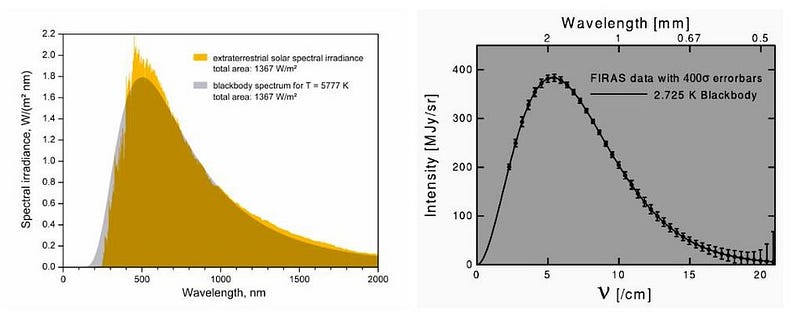
The Cosmic Microwave Background’s temperature was first measured to this precision back in 1992, with the first data release of NASA’s COBE satellite. But the neutrino background imprints itself in a very subtle way, and wasn’t detected until 2015. When it was finally discovered, the scientists who did the work found a phase shift in the Cosmic Microwave Background’s fluctuations that enabled them to determine, if neutrinos were massless today, how much energy they’d have at this early time.
Their results? The Cosmic Neutrino Background had an equivalent temperature of 1.96 ± 0.02 K, in perfect agreement with the Big Bang’s predictions.
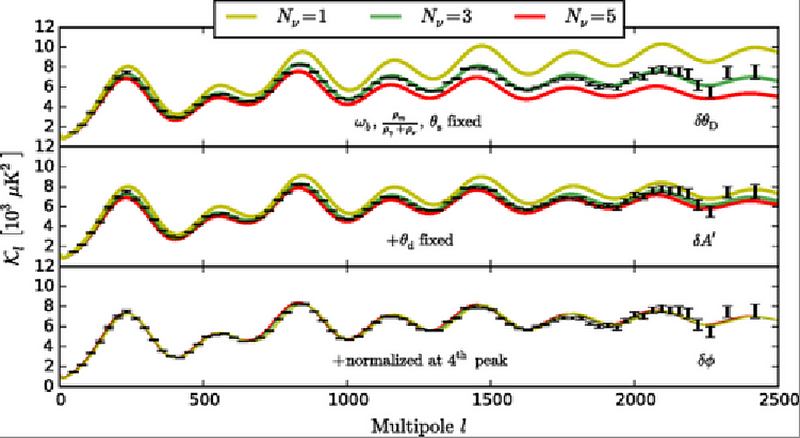
Because of the brief amount of time the weak interactions were important and antimatter persisted, the Universe is not 50/50 between protons and neutrons anymore, but rather split more like 72/28, in favor of protons. With the neutrinos and antineutrinos completely decoupled from all the other particles in the Universe, they simply move through space freely, at speeds indistinguishable (but slightly lower than) the speed of light. Meanwhile, the anti-electrons are all gone, and so are most of the electrons.
When the dust clears, there are exactly as many electrons as there are protons, keeping the Universe electrically neutral. There are over a billion photons for every proton or neutron, and about 70% as many neutrinos-and-antineutrinos as photons. The Universe is still hot and dense, but it’s cooled tremendously in just the first 3 seconds. Without all that antimatter, the raw ingredients for stars are falling into place.
Ethan Siegel is the author of Beyond the Galaxy and Treknology. You can pre-order his third book, currently in development: the Encyclopaedia Cosmologica.





